Layout and features
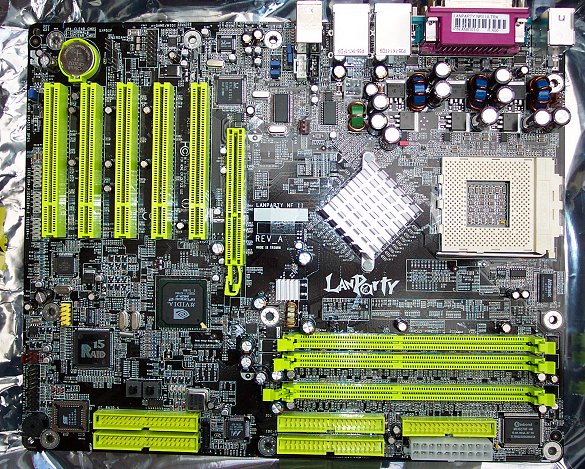
It's pretty, isn't it ?.
The mix of dark-brown PCB colouring and lime-green slots and ports gives
it a distinctive look. What's more, fire some UV light at the
motherboard and watch the slots react. Definitely one for those that
value aesthetics. A couple of safety strips around the CPU socket
prevent rogue screwdriver jabs (when installing the heatsink) from
damaging the PCB.
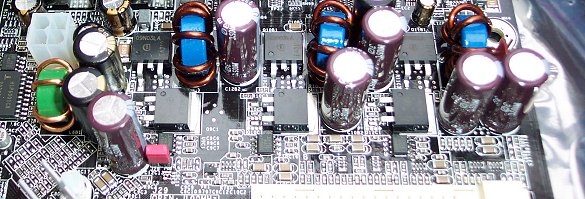
A quick perusal of the
socket area leaves us a little deflated. Mounting holes are conspicuous
by their absence. You can clearly see that components line the side of
the socket. The user will have to make do with cooling that fits around
the ZIFF lugs; a little disappointing. The obligatory 4-pin 12v power
connector is in a odd location, sitting alongside the power-smoothing
capacitors.
The RAM area is clean and
relatively uncluttered, and one can remove and install system memory
without having to wrestle with an oversized AGP card. The main 20-pin
power connector's position also deserves a little praise. After
reviewing a number of motherboards in the past year, this location is
most conducive for neat cabling. Another appreciated touch is the
passive heatsink employed on the nForce2 Ultra 400 SPP NB.
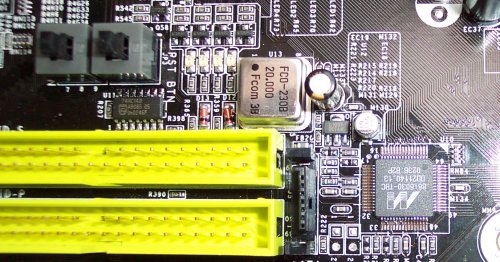
Casually moving on down
the board brings us to a quartet of features. The extra 2 IDE ports and
Marvell 88i8030 bridge informs us that we've got SATA support hitched on
to the ATA controller. DFI
plays the SATA game very lightly by not specifying a separate SATA
PCI-based link. A single SATA port, pictured above, is a token gesture
to the emerging SATA crowd, and it takes the place of the primary master
channel when active. The two buttons are an invaluable tool for
the tester. They serve and power and reset buttons, much like some of
ABIT's earlier boards. The 4 LEDs to the right of the two buttons are a basic diagnostic
tool, as they flash in a sequence during POST. Any
problems will cause the LEDs to remain lit in a certain combination,
which can be cross-referenced against the manual.
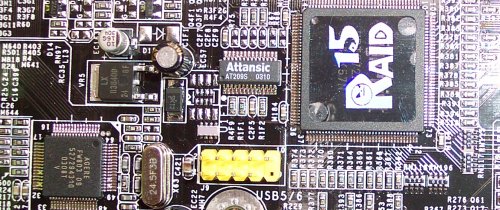
A flash-ridden picture
shows Highpoint's HPT372N RAID controller in all its glory. DFI is keen
to ensure that standard ATA RAID isn't forgotten in the frenzy that
surrounds the sexy SATA format. The controller offers RAID0, RAID1, RAID
0+1 and RAID1.5 support. What's RAID1.5, we hear you say. It's the
ability to both mirror and stripe using only 2 drives. Strange and
novel. The omission of FireWire support was one of the small number of
negative comments we made in reference to the Canterwood model. Agere provide the
three-port FW803 physical layer and three associated FireWire headers are found close
by, two of which are usable via the supplied bracket.
DFI uses NVIDIA's feature-filled MCP-T Southbridge to provide a plethora
of useful, integrated extras. Note that the CMOS battery and jumper have
been moved down to the left-hand side of the 5th PCI slot. That location
is excellent. It's easy to get to the CMOS jumper; there's no messing around
trying to remove it with a number of other components getting in the way.
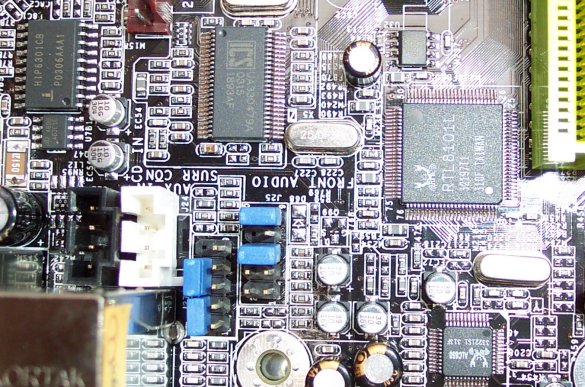
The ALC650 6-channel
sound CODEC allows DFI to route NVIDIA's excellent on-board sound, via
three analogue jacks, to the outside world. A S/PDIF connection is
present and gives the board Soundstorm status. The RTL8101L 10/100 LAN,
however, is a single-chip standalone Fast Ethernet controller. It's how
DFI manages to incorporate dual LAN support on this model. The usefulness
of Dual LANs has risen since the popularity of home networking has
increased hugely in recent years. If you feel that ~ 2v just isn't enough juice
for your liking, then attaching a variable resistor to the HIP6301CB
chip, pictured left, should give you all that even refrigerant-based
cooling can handle.

Dual LAN and 4 USB 2.0
ports stand out here. DFI chooses to go with Realtek and not the
integrated 3COM solution. A FireWire port would have been welcome on the
back panel.









